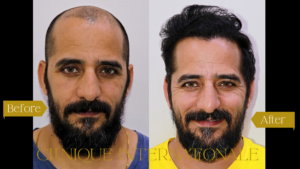Is Hair Transplantation a Trustworthy Solution for Baldness?

What is Hair Transplantation?
Hair transplantation is a surgical procedure in which hair follicles from one part of the body (usually the back or sides of the head) are moved to areas experiencing thinning or baldness. The goal is to restore hair growth in areas that no longer grow hair naturally. This procedure has grown in popularity because it provides permanent results, making it a reliable solution for many people who suffer from baldness.
How Does Hair Transplantation Work?
The process of hair transplantation involves two main techniques:
- FUE (Follicular Unit Extraction): In this method, individual hair follicles are extracted from the donor area and implanted into the thinning or bald areas. FUE is less invasive and leaves no noticeable scars.
- FUT (Follicular Unit Transplantation): This method involves removing a strip of scalp from the donor area. The strip is then divided into smaller units of hair follicles and transplanted to the balding area. Although FUT may leave a linear scar, it is still a highly effective method for hair restoration.
Both methods aim to give natural-looking results. However, FUE is more popular today due to its minimally invasive nature.
Why Do People Choose Hair Transplantation?
Many people opt for hair transplantation because it offers long-lasting results. Unlike topical treatments or medications, which may stop working overtime or have side effects, hair transplant surgery provides a permanent solution. Once the transplanted hair starts growing, it continues to grow naturally for years, making it a trustworthy choice for those serious about combating hair loss.
Is Hair Transplantation Safe?
Yes, hair transplantation is generally considered safe when performed by experienced professionals, like those at Clinique Internationale under the expertise of Dr. Idris. The procedure is minimally invasive and typically doesn’t require a lengthy recovery period. Most patients can return to normal activities within a few days, though there might be some mild swelling or discomfort initially.
As with any medical procedure, there are risks involved, such as infection or scarring, but these are rare if proper aftercare instructions are followed. Dr. Idris and his team guide you through every step of the process to ensure the best possible outcome.
Benefits of Hair Transplantation
- Permanent Solution: One of the key benefits of hair transplant surgery is its permanent nature. Unlike other treatments, the results last a lifetime, and the transplanted hair grows just like natural hair.
- Natural-Looking Results: With modern techniques like FUE, the results are natural and blend seamlessly with the existing hair. It is hard to tell that a transplant has been done, making it a great option for those who want a discreet solution.
- Boosts Confidence: Baldness can affect a person’s self-esteem. Hair transplantation helps restore not just hair but also confidence. Many people experience a boost in their self-image after the procedure.
- Minimal Maintenance: Once the transplanted hair begins to grow, it requires minimal maintenance. You can treat it just like your natural hair, with no special shampoos or treatments needed.
What to Expect After the Procedure?
After your hair transplant, you will likely experience some mild swelling or discomfort, but this typically goes away within a few days. It’s important to follow your doctor’s post-surgery care instructions to ensure the best healing and hair growth. Within a few months, you will start to see new hair growing in the transplanted areas. However, it may take up to a year for the full results to become visible.
Final Thoughts
Related Article
